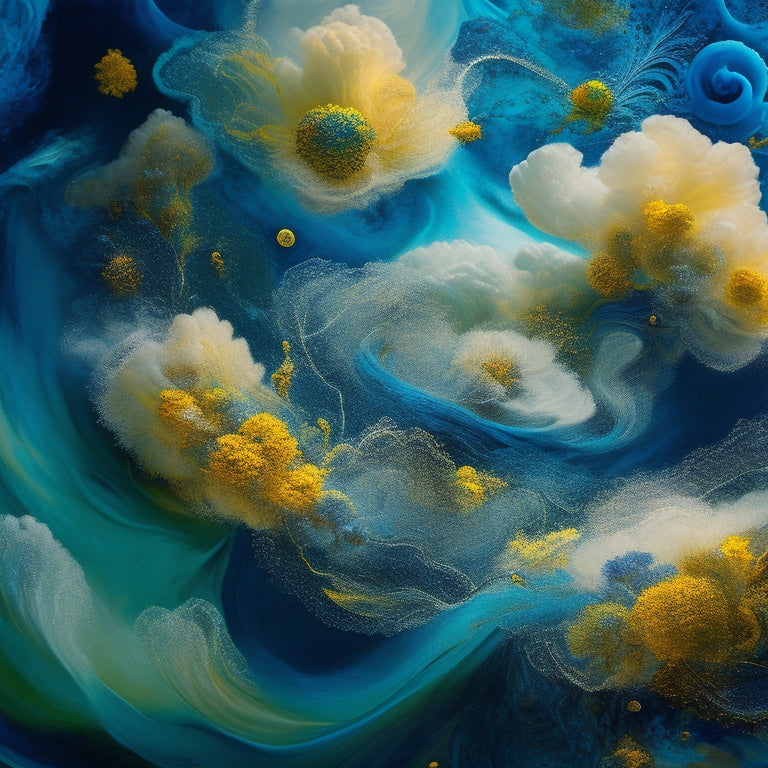
Unlocking the Art of Acrylic Pouring
Share
I've deciphered the secret to unraveling the art of acrylic pouring. By stocking my studio with essential supplies like reusable cups, heat guns, and natural stir sticks, I've set myself up for success. Mastering paint mixing techniques with high-pigment strength paints and Flood Floetrol has taken my art to the next level. A well-organized workspace with proper ventilation and creative storage solutions has allowed me to focus on the art itself. Now, I'm experimenting with unique surfaces and refining my techniques to achieve the perfect pour. With every new discovery, I'm getting closer to pushing the boundaries of this enthralling medium.
Key Takeaways
• Master paint mixing techniques using high-pigment strength paints, Flood Floetrol, and condiment bottles with mesh strainers and marbles.
• Set up a safe and efficient workspace with reusable fast food trays, window fan fume hood, and IKEA Billy bookcases as drying racks.
• Choose the right surfaces, including canvases and wood panels, and prepare them with Liquitex gesso and light sanding for optimal texture and adhesion.
• Invest in essential tools like reusable cups, heat guns, natural stir sticks, and black nitrile gloves to ensure a smooth creative process.
• Focus on achieving a smooth, even consistency in your paint mixture to unlock unique, high-quality acrylic pouring art.
Essential Supplies and Materials
I equip my workspace with reusable cups and containers, a heat gun, natural material stir sticks, a propane torch, and black nitrile gloves to guarantee a well-equipped environment for my acrylic pouring art.
As a conscious artist, I opt for eco-friendly options like reusable cups and natural stir sticks to reduce waste. Additionally, I choose affordable alternatives like heat guns and propane torches, which are just as effective as their high-end counterparts.
Mastering Paint Mixing Techniques
With a well-equipped workspace, I direct my attention to the art of mixing paints. The right combination of products and techniques can make all the difference in achieving unique, eye-catching effects.
I start by selecting high-pigment strength paints, such as TriArt or Golden acrylics, and adding Flood Floetrol to achieve the perfect pouring consistency.
Next, I focus on color blending, experimenting with different ratios of colors to create unique hues. I mix my paints in condiment bottles with mesh strainers and marbles, ensuring a smooth, even consistency.
Setting Up Your Workspace
By designating a specific area for acrylic pouring and equipping it with essential tools and surfaces, you'll be able to minimize mess, maximize efficiency, and focus on the creative process.
I prioritize workspace organization by using reusable fast food trays for paint and resin drips, and a washing machine drain pan for containing messes.
For ventilation options, I create a window fan fume hood to remove harsh fumes. I also opt for creative storage solutions like IKEA Billy bookcases as drying racks.
An essential setup is important, ensuring a level area to pour and dry paintings. By setting up my workspace thoughtfully, I can focus on the art of acrylic pouring, experimenting with new techniques and recipes while maintaining a safe and efficient environment.
Choosing the Right Surfaces
Choosing the perfect surface for acrylic pouring is vital, as it directly impacts the painting's texture, adhesion, and overall appearance. As I explore the world of fluid art, I've discovered that surface selection is essential.
Canvases are a popular choice, but I also enjoy experimenting with wood panels for a unique texture. When preparing canvases, I always prime them with a coat of Liquitex gesso to guarantee a smooth, even surface. For wood panels, I sand them lightly to create a rough texture that allows the paint to adhere better.
Tips and Resources for Success
I've found that having the right tools, resources, and techniques at my disposal is vital to harnessing the full potential of acrylic pouring art.
When experimenting with colors, textures, and exploring different finishes, effects, I rely on my trusted favorites: reusable cups, heat guns, and natural material stir sticks.
I also invest in Flood Floetrol, Liquitex gloss medium, and TriArt or Golden acrylic paint for high pigment strength.
For mixing, I use condiment bottles with mesh strainers and marbles.
To guarantee a safe and efficient setup, I utilize IKEA Billy bookcases as drying racks, reusable fast food trays, and a window fan fume hood.
Frequently Asked Questions
How Do I Avoid Creating Air Pockets in My Poured Paintings?
When I mix paints, I guarantee bubble prevention by gently stirring and scraping the sides of my condiment bottles, as surface tension can cause trapped air, which I release by tapping the bottle before pouring.
Can I Use Household Items as Molds for Unique Shapes?
"I experiment with household items as molds, embracing Mold Hacks for unique shapes. I carefully select items like silicone cake pans, plastic containers, and even natural materials like leaves, ensuring a safe, creative Shape Exploration process."
What Safety Precautions Should I Take When Working With Resin?
As I venture into the world of resin, I'm enveloped in a cloud of uncertainty, but I'm determined to prioritize safety. I'll don black nitrile gloves to shield my skin from resin allergies, and invest in a proper ventilation system to banish hazardous fumes.
How Do I Achieve a Specific Color Palette in My Pours?
When planning a color palette, I rely on Color Theory principles, considering harmony, contrast, and saturation to achieve a cohesive look. I also practice Palette Planning, testing colors and ratios to secure a desired outcome in my acrylic pours.
Can I Use Acrylic Pouring Techniques With Other Art Mediums?
I love experimenting with mixed media, combining acrylic pouring with other art forms like ink, paper, or fabric. I'm always on the lookout for new, safe, and innovative ways to merge techniques, pushing boundaries and creating unique, visually striking pieces.